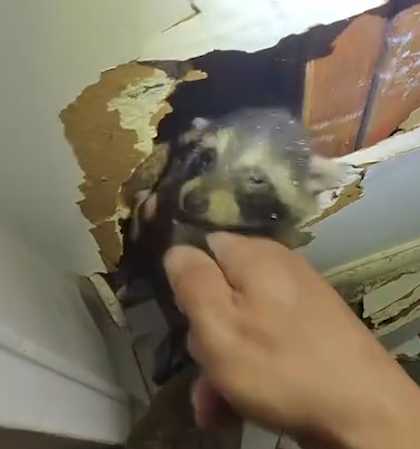When Wildlife Comes Indoors: The Rescue of Three Baby Raccoons and What It Teaches Us About Coexistence
Introduction
Wildlife encounters are not always about hiking trails, forests, or distant national parks. Sometimes, they happen in the most unexpected of places—inside our own homes. For one homeowner, unusual scratching and faint cries behind a wall sparked a series of events that revealed an extraordinary story of resilience, quick action, and the delicate relationship between people and wild animals.
This real-life rescue of three baby raccoons is not only a heartwarming story but also a valuable lesson about habitat loss, humane wildlife management, and the responsibility humans carry when living close to nature. By walking through each stage of the discovery and rescue, and then widening the lens to explore why such events happen, we can better understand how to coexist peacefully with the animals who share our neighborhoods.
The First Signs: Strange Noises in the Walls
The incident began when a homeowner started hearing persistent scratching, shuffling, and faint whimpering sounds inside the walls of their house. At first, the noises were puzzling—after all, a house wall is not where one would expect to hear animal activity.
The sounds had been ongoing for a couple of days, becoming more frequent and more urgent. Concerned about both the integrity of their home and the welfare of whatever was trapped inside, the homeowner decided to seek help.
Adding to the mystery was another observation: a raccoon that had been a familiar sight around the property had not been seen in several days. The absence seemed unusual, especially considering raccoons are typically active at night and often spotted near food sources, garbage bins, or climbing trees.
Just days before the noises began, a large tree near the property had been removed. This detail, which might have seemed unrelated at first, turned out to be a vital clue.
A Vital Connection: Trees as Raccoon Habitats
Raccoons are incredibly adaptable animals. They live in both rural forests and bustling cities, relying on a mix of natural and man-made shelters. One of their favorite nesting places is the hollow of a large, mature tree. Such spots provide safety, cover, and an ideal environment for raising young kits (baby raccoons).
When the homeowner mentioned that the removed tree had been a favorite climbing spot for the raccoons in the area, the picture became clearer. It was highly likely that the tree had housed a mother raccoon and her babies. With its sudden removal, the mother would have been forced to find a new location. In her search for safety, she may have entered the house through an exterior gap, eventually leading her to the cavity of the wall.
This was the first crucial realization: the noises were not random, but the cries of young animals that had likely become trapped.
On-Site Assessment: A Careful Approach
When wildlife specialists arrived, their first priority was to handle the situation with sensitivity. The goal was to ensure safety for both the animals and the homeowners while avoiding unnecessary damage to the property.
The team began with a thorough inspection, looking for exterior openings, chew marks, droppings, or other signs of animal activity. Using a thermal imaging camera, they were able to confirm what the human ear had already suspected: small warm bodies were huddled inside the wall cavity.
The faint cries, combined with the heat signature, indicated that the animals were alive but in distress. The placement of the heat spots suggested that the young raccoons had fallen into a deeper part of the wall, likely when their mother attempted to relocate them after the tree was cut down.
The Discovery: Three Baby Raccoons
After determining the exact spot, the specialists carefully opened a section of drywall. Behind the wall, nestled together, were three baby raccoons—only a few weeks old. Their fur was matted, and they showed visible signs of dehydration. It became clear that they had been without food and proper care for several days.
Normally, in similar situations, the preferred approach would be to place rescued babies outside in a secure box. This would allow the mother raccoon to return under the cover of night to retrieve her young. Raccoon mothers are known to move their babies one by one to safer locations, and they rarely abandon them unless absolutely necessary.
Unfortunately, in this case, too much time had passed. The mother had not been seen for days, and the babies’ condition suggested that she either could not access them or had been permanently separated from them due to the sudden removal of the tree.
Emergency Response: Transport to a Wildlife Rehabilitation Center
With the kits’ survival at risk, the team decided on immediate intervention. The baby raccoons were gently gathered and transported to a licensed wildlife rehabilitation center. There, they could receive the fluids, nutrition, warmth, and medical care needed to restore their health.
Licensed wildlife rehabilitators play an essential role in such cases. They are trained to provide specialized care that prepares animals not just to survive, but eventually to thrive back in the wild. For the three raccoon kits, this meant a carefully monitored process of recovery—first focusing on rehydration and feeding, then slowly building strength until they could be released when old enough to fend for themselves.
Why These Rescues Matter: The Human-Wildlife Connection
This case was more than just a dramatic rescue. It highlighted several important issues that affect communities everywhere:
- Habitat Disruption – The removal of trees, construction projects, and urban expansion all reduce the available safe spaces for wildlife. Even small changes, like cutting down a single tree, can displace entire families of animals.
- Wildlife Adaptability – Animals like raccoons adapt quickly to changes in their environment. They use attics, sheds, chimneys, and even wall cavities when natural shelters are removed.
- Human Responsibility – While property owners have every right to maintain and protect their homes, it’s important to take into account the impact on local wildlife. Checking for nests before removing trees or sealing entry points can prevent tragedies.
- The Role of Professionals – Attempting to remove wild animals without expertise can endanger both humans and the animals themselves. Calling professionals ensures that interventions are safe, legal, and humane.
Educational Insights: What Homeowners Should Know
Stories like this often leave people asking: What can I do if this happens in my own home? Here are a few guidelines for homeowners:
- Listen for Clues: Scratching, scurrying, or muffled cries in walls or attics may indicate trapped animals.
- Check Before Tree Removal: Before cutting down large trees, especially those with cavities, inspect for nests or animal activity.
- Avoid DIY Trapping: Handling wild animals without training can be dangerous. Some species carry diseases, and improper handling may harm the animals.
- Use Humane Exclusion: If animals are in attics or chimneys, professionals can use one-way doors or exclusion techniques that allow animals to leave without re-entering.
- Support Rehabilitation Centers: Licensed wildlife rehabilitators depend on community awareness and support to continue their work.
Broader Implications: Coexisting With Wildlife
Urban and suburban areas are expanding, and with that expansion comes increased overlap between human activity and animal habitats. Raccoons are only one example. Squirrels, birds, bats, opossums, and even foxes often adapt to residential areas.
The key is not to view these animals as intruders, but as neighbors sharing the environment. When conflicts arise, humane solutions should always be the first option. Whether through education, wildlife corridors, or community programs, there are many ways to promote coexistence.
A Happy Outcome
Thanks to the quick response of the homeowner, the expertise of the wildlife rescue team, and the dedication of rehabilitators, three young raccoons were given a second chance at life. While they did not reunite with their mother, they avoided what would have otherwise been a tragic end.
This story reminds us of an important truth: small actions can save lives. Vigilance, compassion, and respect for nature create the foundation for harmonious living between people and wildlife.
Conclusion
The case of the raccoons in the wall illustrates a broader narrative that plays out in many communities around the world. Human development and wildlife survival are deeply connected, and with mindful practices, both can thrive.
For the rescued raccoon kits, the journey was just beginning. With proper care, they would grow strong enough to be released back into the wild—an outcome that underscores the power of community action and the importance of respecting the natural world.
In the end, what started as a few strange noises inside a home became a story of hope, responsibility, and renewal.


